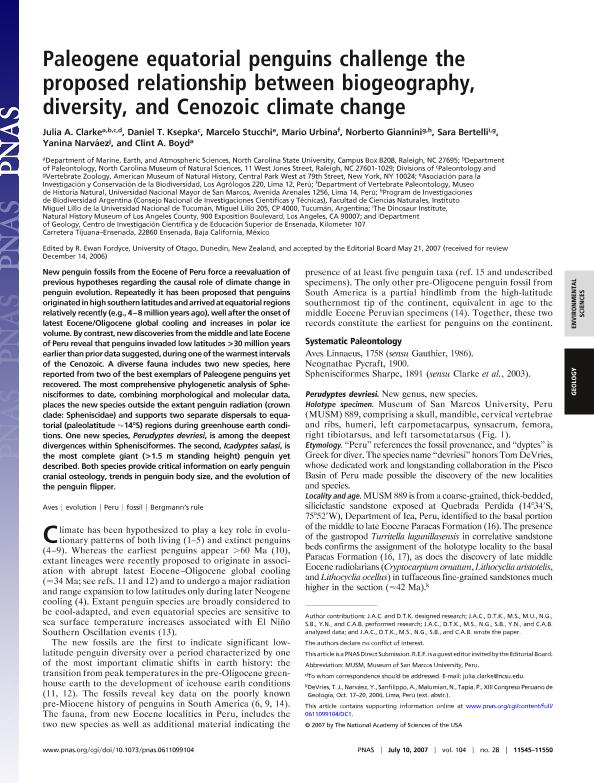Mostrar el registro sencillo del ítem
dc.contributor.author
Clarke, Julia A.
dc.contributor.author
Sepka, Daniel K.
dc.contributor.author
Stucchi, Marcelo
dc.contributor.author
Urbina, Mario
dc.contributor.author
Giannini, Norberto Pedro

dc.contributor.author
Bertelli, Sara Beatriz

dc.contributor.author
Narváez, Yanina
dc.contributor.author
Boyd, Clint A.
dc.date.available
2019-09-09T19:44:57Z
dc.date.issued
2007-12
dc.identifier.citation
Clarke, Julia A.; Sepka, Daniel K.; Stucchi, Marcelo; Urbina, Mario; Giannini, Norberto Pedro; et al.; Paleogene equatorial penguins challenge the proposed relationship between biogeography, diversity, and Cenozoic climate change; National Academy of Sciences; Proceedings of the National Academy of Sciences of The United States of America; 104; 28; 12-2007; 11545-11550
dc.identifier.issn
0027-8424
dc.identifier.uri
http://hdl.handle.net/11336/83181
dc.description.abstract
New penguin fossils from the Eocene of Peru force a reevaluation of previous hypotheses regarding the causal role of climate change in penguin evolution. Repeatedly it has been proposed that penguins originated in high southern latitudes and arrived at equatorial regions relatively recently (e.g., 4–8 million years ago), well after the onset of latest Eocene/Oligocene global cooling and increases in polar ice volume. By contrast,newdiscoveries from the middle and late Eocene of Peru reveal that penguins invaded low latitudes >30 million years earlier than prior data suggested, during one of the warmest intervals of the Cenozoic. A diverse fauna includes two new species, here reported from two of the best exemplars of Paleogene penguins yet recovered. The most comprehensive phylogenetic analysis of Sphenisciformes to date, combining morphological and molecular data, places the new species outside the extant penguin radiation (crown clade: Spheniscidae) and supports two separate dispersals to equatorial (paleolatitude 14°S) regions during greenhouse earth conditions. One new species, Perudyptes devriesi, is among the deepest divergences within Sphenisciformes. The second, Icadyptes salasi, is the most complete giant (>1.5 m standing height) penguin yet described. Both species provide critical information on early penguin cranial osteology, trends in penguin body size, and the evolution of the penguin flipper.
dc.format
application/pdf
dc.language.iso
eng
dc.publisher
National Academy of Sciences

dc.rights
info:eu-repo/semantics/openAccess
dc.rights.uri
https://creativecommons.org/licenses/by-nc-sa/2.5/ar/
dc.subject
Sphenisciformes
dc.subject
Paleontology
dc.subject
Climate Change
dc.subject.classification
Zoología, Ornitología, Entomología, Etología

dc.subject.classification
Ciencias Biológicas

dc.subject.classification
CIENCIAS NATURALES Y EXACTAS

dc.title
Paleogene equatorial penguins challenge the proposed relationship between biogeography, diversity, and Cenozoic climate change
dc.type
info:eu-repo/semantics/article
dc.type
info:ar-repo/semantics/artículo
dc.type
info:eu-repo/semantics/publishedVersion
dc.date.updated
2019-08-29T15:42:36Z
dc.journal.volume
104
dc.journal.number
28
dc.journal.pagination
11545-11550
dc.journal.pais
Estados Unidos

dc.journal.ciudad
New York
dc.description.fil
Fil: Clarke, Julia A.. North Carolina State University; Estados Unidos
dc.description.fil
Fil: Sepka, Daniel K.. American Museum of Natural History; Estados Unidos
dc.description.fil
Fil: Stucchi, Marcelo. Universidad Nacional Mayor de San Marcos; Perú
dc.description.fil
Fil: Urbina, Mario. Universidad Nacional de Tucumán. Facultad de Ciencias Naturales e Instituto Miguel Lillo. Programa de Investigación de Biodiversidad Argentina; Argentina
dc.description.fil
Fil: Giannini, Norberto Pedro. Consejo Nacional de Investigaciones Científicas y Técnicas. Centro Científico Tecnológico - Tucumán. Unidad Ejecutora Lillo; Argentina
dc.description.fil
Fil: Bertelli, Sara Beatriz. Consejo Nacional de Investigaciones Científicas y Técnicas. Centro Científico Tecnológico - Tucumán. Unidad Ejecutora Lillo; Argentina
dc.description.fil
Fil: Narváez, Yanina. Natural History Museum of Los Angeles County; Estados Unidos
dc.description.fil
Fil: Boyd, Clint A.. North Carolina State University; Estados Unidos
dc.journal.title
Proceedings of the National Academy of Sciences of The United States of America

dc.relation.alternativeid
info:eu-repo/semantics/altIdentifier/url/https://www.pnas.org/content/104/28/11545
dc.relation.alternativeid
info:eu-repo/semantics/altIdentifier/doi/https://dx.doi.org/10.1073/pnas.0611099104
Archivos asociados
